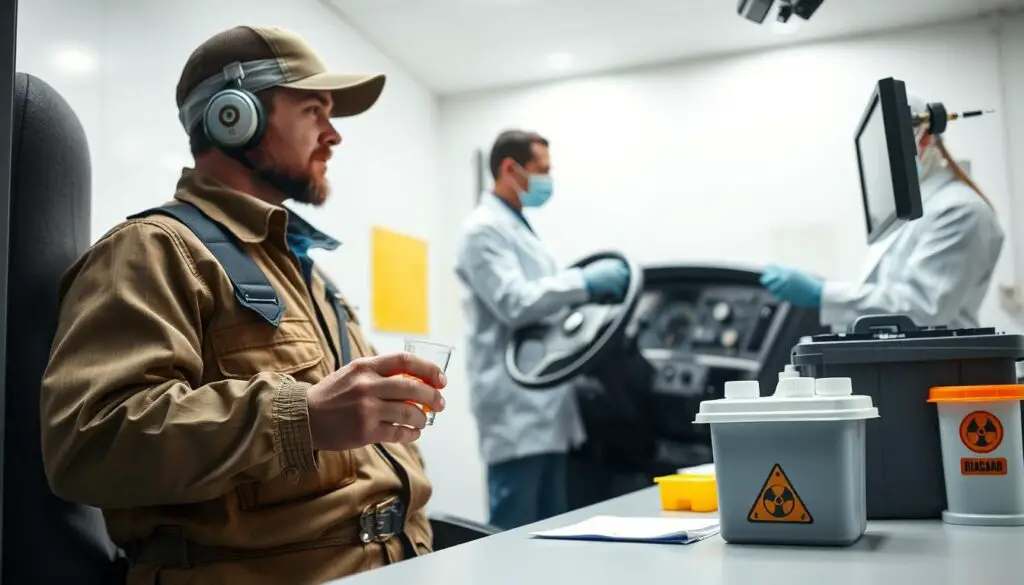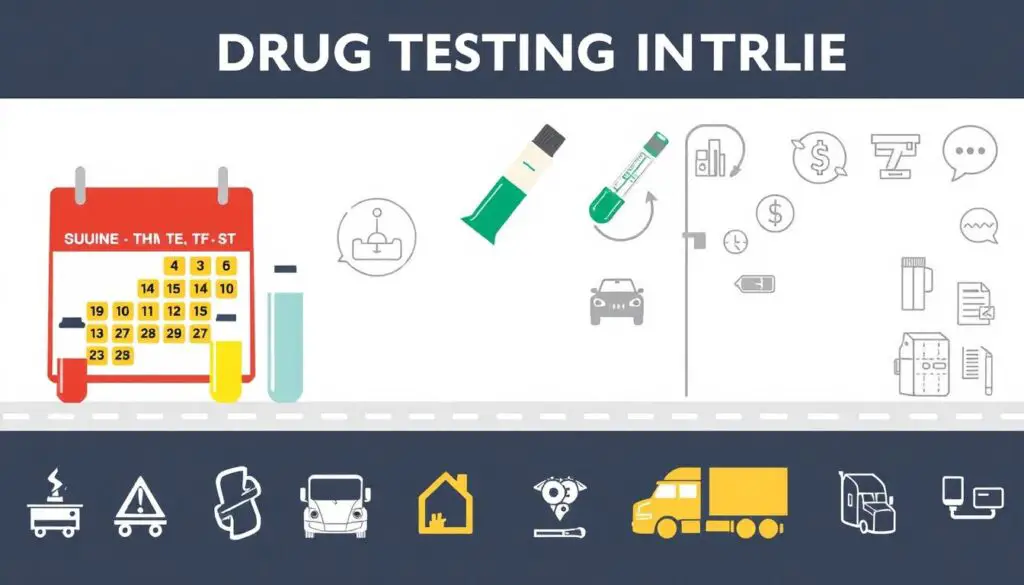Truck drivers are key to America’s commerce. They keep goods moving across the country. But, they must stay drug-free for everyone’s safety. This guide looks at how often truck drivers get tested, the rules, and its effects on the trucking world.

Keeping drivers safe and following the rules is crucial. Knowing the DOT’s drug testing rules helps drivers and companies. It ensures our roads are safe and efficient for everyone.
Understanding DOT Drug Testing Requirements for Commercial Drivers
The Department of Transportation (DOT) has strict rules for drug testing in the trucking industry. These rules are set by the Federal Motor Carrier Safety Administration (FMCSA). They apply to anyone driving a commercial vehicle as part of their job.
Pre-Employment Testing Protocols
Employers must test drivers for drugs before hiring them. This test is required to make sure the driver isn’t using illegal substances. The driver must pass this test to start driving a commercial vehicle.
Random Testing Selection Process
DOT also requires random drug and alcohol tests for drivers. Employers pick a certain number of drivers for testing each year. This helps keep the workplace safe and compliant with rules.
Post-Accident Testing Guidelines
If a commercial vehicle is involved in an accident, the driver must be tested for drugs and alcohol. This is part of the DOT’s safety rules. It helps find out if the driver was impaired during the accident.
Following these DOT drug testing rules is crucial for drivers and their employers. It helps make the trucking industry safer for everyone. This benefits both the drivers and the public.
How Often Do Truck Drivers Get Drug Tested
Truck drivers in the United States face strict drug testing rules set by the Department of Transportation (DOT). These rules aim to keep drivers and the public safe on the roads. But, how often do truck drivers get tested?
The DOT requires commercial motor vehicle (CMV) drivers to be tested at least 50% each year. This means half of all truck drivers are randomly tested annually. Employers can test more often, but 50% is the minimum.
Truck drivers also get tested before starting work and after any accidents. After accidents, tests check if drugs played a role. Drivers who test positive may face more tests to get back on the road.
| Drug Test Frequency | Annual Testing Rates | DOT Testing Intervals |
|---|---|---|
| Random | Minimum 50% of drivers | Annually |
| Pre-Employment | 100% of new hires | Once, before starting work |
| Post-Accident | Required after reportable incidents | Immediately following accident |
| Return-to-Duty | Increased rates for prior violations | Varies based on circumstances |
Testing truck drivers often is key to a safe transportation industry. By following DOT rules, employers help keep drivers safe from drugs.
“Drug and alcohol use among commercial motor vehicle drivers poses a serious threat to public safety. Rigorous testing protocols are essential to identify and remove impaired drivers from our roadways.”

Types of Drug Tests for Commercial Truck Drivers
In the trucking world, safety is key. To keep drivers and the public safe, commercial truck drivers face various drug tests. These tests are crucial for a safe and reliable transport system.
Urine Drug Testing Procedures
The most common test for truck drivers is the DOT-approved urine drug test. It’s reliable and can find many substances like marijuana and cocaine. These tests can spot drug use from a few days to a week ago.
Hair Follicle Testing Methods
Some companies also use hair follicle tests. These tests can find drug use for months, giving a clearer picture of a driver’s history. They’re seen as more accurate and can show patterns of drug use.
Breath Alcohol Testing Requirements
Truck drivers also have to pass breath alcohol tests. DOT-approved breathalyzers check the driver’s blood alcohol level. It must be under 0.04% to drive. These tests happen during random checks, after accidents, or if there’s suspicion of alcohol use.
These tests help keep the trucking industry safe. They ensure drivers are safe and the public is protected.
| Drug Screening Method | Detection Window | DOT Approval Status |
|---|---|---|
| Urine Drug Test | Few days to 1 week | Approved |
| Hair Follicle Test | Up to several months | Approved |
| Breath Alcohol Test | Immediate | Approved |

“Maintaining a safe and reliable transportation system is our top priority, and the drug testing protocols for commercial truck drivers are a critical component in achieving this goal.”
Consequences of Failed Drug Tests in Trucking Industry
In the trucking world, failing a drug test can lead to serious consequences. The Federal Motor Carrier Safety Administration (FMCSA) has a strict no-tolerance policy on substance abuse. This means a driver can face immediate CDL disqualification.
After a failed drug test, drivers must go through the return-to-duty process. This involves a detailed evaluation by a Substance Abuse Professional (SAP) and finishing a substance abuse program. This process is long and expensive. It can lead to job loss and make it hard to find work in the industry again.
| Consequence | Description |
|---|---|
| CDL Disqualification | Immediate suspension of the commercial driver’s license (CDL) for a minimum of 1 year. |
| Return-to-Duty Process | Mandatory evaluation by a Substance Abuse Professional (SAP) and completion of a prescribed substance abuse program. |
| Career Challenges | Difficulty finding future employment in the trucking industry due to the failed drug test on their record. |
The trucking industry’s zero-tolerance policy on substance abuse is to keep everyone safe. A failed drug test can greatly affect a driver’s career and life. It shows how crucial it is to follow the FMCSA’s strict rules.
Conclusion
In the trucking world, keeping workplaces drug-free and following safety rules is key. Truck drivers face strict drug tests from the Department of Transportation (DOT). These tests help keep everyone safe on the roads.
Drivers need to know about drug testing rules to stay safe. By staying clean and following the rules, drivers protect their jobs and everyone’s safety. This helps make the drug-free workplace, safety compliance, and industry standards better for all.
Truck drivers are crucial for our country’s goods and services. They help keep everything moving smoothly. By being responsible and accountable, truckers help keep our roads safe for everyone.
FAQ
What is the frequency of drug testing for truck drivers?
The Department of Transportation (DOT) and the Federal Motor Carrier Safety Administration (FMCSA) set the rules. Truck drivers must pass pre-employment, random, post-accident, and reasonable suspicion drug tests. They must do this at least 50% of the time, based on the total number of drivers.
How are truck drivers randomly selected for drug testing?
Employers pick drivers for drug tests using a random number generator. This makes sure everyone has an equal chance of being tested. Employers must test at least 50% of their drivers each year.
What happens if a truck driver fails a drug test?
Failing a drug test can lead to big problems. Drivers might lose their Commercial Driver’s License (CDL). They must go through a return-to-duty process. This includes an evaluation, treatment, and follow-up tests before they can drive again.
What types of drug tests are used for truck drivers?
Truck drivers are tested with urine and breath alcohol tests. These are approved by the DOT. Some employers also use hair follicle tests to check for drug use over time.
How do post-accident drug tests differ from other testing scenarios?
Post-accident tests are required if there’s a fatality or a moving violation citation. Employers must do these tests quickly. They have 32 hours for drug tests and 8 hours for alcohol tests.
